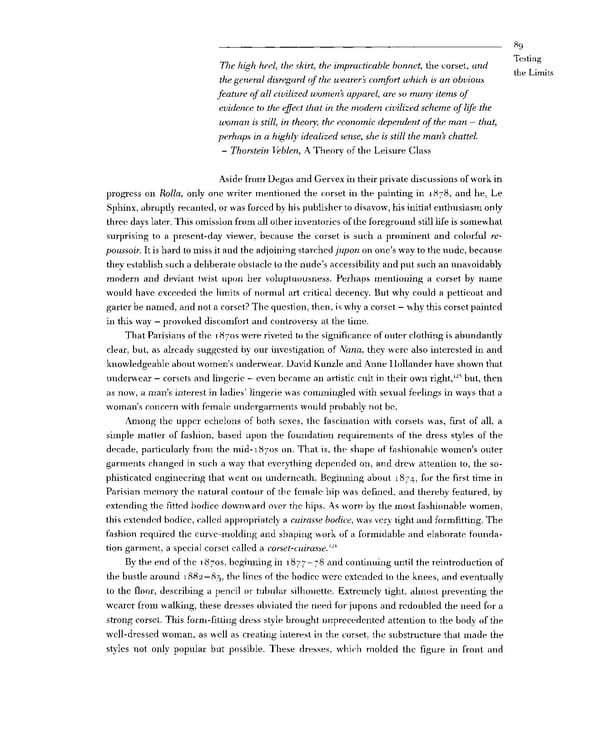»9 The high heel, the skirt, the impracticable bonnet, the corset, and Testing the general disregard of the wearer's comfort which is an obvious the Limits feature of all civilized women's apparel, are so many items of evidence to the effect that in the modern civilized scheme of life the woman is still, in theory, the economic dependent of the man - that, perhaps in a highly idealized sense, she is still the man's chattel. - Thorstein Veblen, A Theory of the Leisure Class Aside from Degas and Gervex in their private discussions of work in progress on Rolla, only one writer mentioned the corset in the painting in 1878, and he, Le Sphinx, abruptly recanted, or was forced by his publisher to disavow, his initial enthusiasm only three days later. This omission from all other inventories of the foreground still life is somewhat surprising to a present-day viewer, because the corset is such a prominent and colorful re- poussoir. It is hard to miss it and the adjoining starched jupon on one's way to the nude, because they establish such a deliberate obstacle to the nude's accessibility and put such an unavoidably modern and deviant twist upon her voluptuousness. Perhaps mentioning a corset by name would have exceeded the limits of normal art critical decency. But why could a petticoat and garter be named, and not a corset? The question, then, is why a corset - why this corset painted in this way — provoked discomfort and controversy at the time. That Parisians of the 18708 were riveted to the significance of outer clothing is abundantly clear, but, as already suggested by our investigation of Nana, they were also interested in and knowledgeable about women's underwear. David Kunzle and Anne Hollander have shown that 123 underwear - corsets and lingerie - even became an artistic cult in their own right, but, then as now, a man's interest in ladies' lingerie was commingled with sexual feelings in ways that a woman's concern with female undergarments would probably not be. Among the upper echelons of both sexes, the fascination with corsets was, first of all, a simple matter of fashion, based upon the foundation requirements of the dress styles of the decade, particularly from the mid-18705 on. That is, the shape of fashionable women's outer garments changed in such a way that everything depended on, and drew attention to, the so- phisticated engineering that went on underneath. Beginning about 1874, for the first time in Parisian memory the natural contour of the female hip was defined, and thereby featured, by extending the fitted bodice downward over the hips. As worn by the most fashionable women, this extended bodice, called appropriately a cuirasse bodice, was very tight and formfitting. The fashion required the curve-molding and shaping work of a formidable and elaborate founda- 12 tion garment, a special corset called a corset-cuirasse. * By the end of the 18708, beginning in 1877-78 and continuing until the reintroduction of the bustle around 1882-83, the lines of the bodice were extended to the knees, and eventually to the floor, describing a pencil or tubular silhouette. Extremely tight, almost preventing the wearer from walking, these dresses obviated the need for jupons and redoubled the need for a strong corset. This form-fitting dress style brought unprecedented attention to the body of the well-dressed woman, as well as creating interest in the corset, the substructure that made the styles not only popular but possible. These dresses, which molded the figure in front and
 Prostitution & Impressionists Page 109 Page 111
Prostitution & Impressionists Page 109 Page 111